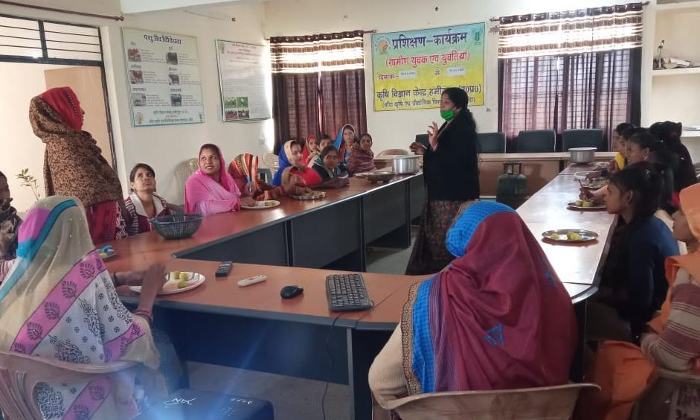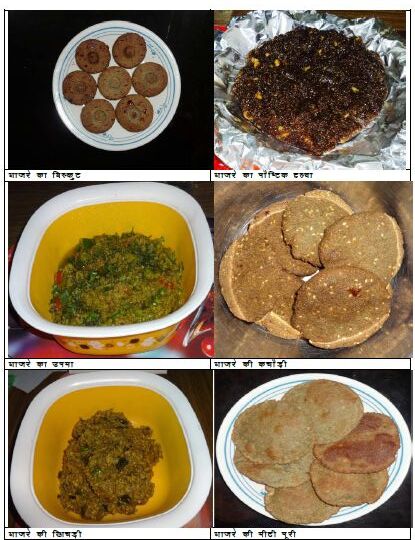Bring home the Bajra
Krishi Vigyan Kendras across Uttar Pradesh are helping reintroduce the nutritious bajra in rural diets, including anganwadis, to combat malnutrition and anaemia in women and children.


Krishi Vigyan Kendras in UP are on a mission to popularise the bajra by inviting rural women to use more of the millet in their cooking. Photo: Krishi Vigyan Kendra, Hamirpur.
Lucknow, Uttar Pradesh
Bajra (pearl millet) holds a special significance in the rural gastronomy of northern India. Numerous folk songs of Punjab, Haryana and Rajasthan sing of the humble grain. Not only is the food made of bajra delicious, but it is also rich in nutrients. In fact, the major cultivation of bajra happens in Rajasthan, Maharashtra, Haryana, Uttar Pradesh and Gujarat.
“In villages, bajra flour is used to make roti and pua (fried sweet dumplings),” Manju Vishwakarma from Sarsai village, Hamirpur district, Uttar Pradesh, about 200 kilometres from the state capital, Lucknow, told Gaon Connection. The 42-year-old regretted that few people were left who were aware of the great nutritional benefits of bajra, and the younger generation was moving further away from it altogether. It is usually looked down upon as the mota anaj (coarse grain), she said.
In an attempt to revive the use of bajra in cooking, 86 Krishi Vigyan Kendras across Uttar Pradesh are on a mission to popularise the bajra by inviting rural women to use more of the millet in their cooking as it is both tasty and extremely nutritious.
According to The Indian Council of Agricultural Research (ICAR), an autonomous body responsible for coordinating agricultural education and research in the country, there are 721 Krishi Vigyan Kendras in the country and 86 of them are in Uttar Pradesh. At each Krishi Vigyan Kendra, experts in the field of women, children and adolescent health, tell rural women about easy ways to stay healthy on a budget.

According to Vishwakarma, in the past year and a half, most of the 150 households in her village had brought home the bajra, and new dishes were being tried out.
The nutritional benefits of bajra are undeniable, said Phoolkumari, home scientist, Krishi Vigyan Kendra, Hamirpur. Regular consumption of bajra helped in combating malnutrition in so many Indians. It is low cost, nutritious and packed in protein, energy, fat, minerals and fibre.
Bajra can be eaten throughout the year. It is also known to be beneficial for diabetics and heart patients. It adds nutrition to the diet of children, the elderly, adolescent girls, pregnant and lactating mothers.
“Now, with bajra being incorporated into the food at anganwadi centres, and introduced into household kitchens, those who have started eating it have shown remarkable improvement in their health, especially those who were previously anaemic,” Phoolkumari pointed out.
Phoolkumari has successfully taught 645 anganwadi workers, 1,058 women farmers, more than 100 adolescent girls and 200 women of various self-help groups to make a variety of dishes from bajra. According to Phoolkumari, bajra contains calcium, phosphorus, zinc, magnesium, potassium, carotin, niacin, vitamin B6, folic acid, iron and a variety of antioxidants. Calcium and phosphorus present in bajra aid the development of bones and reduce the risk of osteoporosis among children and adults. Magnesium regulates blood pressure and soothes migraine and asthma. Bajra also is rich in iron content. The problem of malnutrition and anaemia can be dealt with by using bajra in the diet,” she said.

“I learnt of the benefits of bajra from the Krishi Vigyan Kendra in Hamirpur,” said Vishwakarma. The children at the anganwadi at the village are now served laddu, porridge and khichdi all made from bajra, Vishwakarma said adding there were special bajra dishes for pregnant women and lactating mothers too. “We learnt that if bajra is dried after boiling for a half a minute, its bitterness is reduced and the flour made from it lasts longer besides making soft rotis,” she said.
“The consumption of all coarse cereals like jowar, bajra, sehjan, sesame and linseed is increasing,” Archana Singh, from Krishi Vigyan Kendra, in Mankapur Gonda II, told Gaon Connection. “We train and encourage people to go back to eating coarse grains like their ancestors did,” said Singh.
Bajra is now being used to make popular snacks such as dhokla, idli, laddu, pua, panjiri, mathri, sev, shakkarpare, barfi, biscuits and cakes. Being rich in fibre, bajra keeps digestion healthy.
“During poshan mah (Nutrition Month), we conducted more than hundred training sessions on behalf of ICAR where we shared information on the benefits of bajra,” Nimisha Awasthi, the home science programme assistant at Krishi Vigyan Kendra, Dilipnagar, Kanpur Dehat, told Gaon Connection. Poshan mah is commemorated under the prime minister’s Poshan Abhiyan initiative to encourage people’s participation to address malnutrition amongst children and women and health for all.
Also Read: Millet magic: Kodo and Kutki calling in Chhattisgarh

